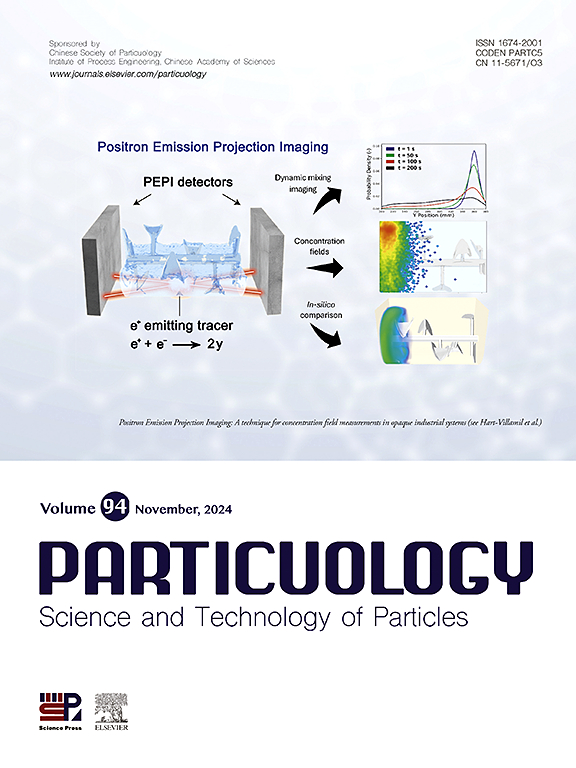微波热解藤废铜金属功能化碳对氯霉素去除效果的优化及f试验研究
IF 4.1
2区 材料科学
Q2 ENGINEERING, CHEMICAL
引用次数: 0
摘要
本研究通过探索利用藤废基金属功能化碳(RMFC)去除废水中氯霉素(CAP)的方法,解决了废水中氯霉素(CAP)的问题。该研究通过离子偶极子和π-π相互作用研究Cu2+功能化在促进CAP吸附中的作用,为研究吸附机理提供了新的见解。利用CuN2O6对RMFC表面进行Cu2+修饰,制备出富铜RMFC (Cu2+-RMFC)。利用响应面法(RSM)对Cu2+-RMFC的制备条件进行了优化。在此之后,进行f检验以评估与等温线和动力学模型相关的线性和非线性方法区分方差的差异,零假设表明这些方差是相同的。原始RMFC和Cu2+-RMFC对CAP的吸附量分别为53.69 mg/g和77.14 mg/g,提高了30.40%。除了氢键、偶极-偶极键和π-π相互作用外,Cu2+-RMFC对CAP的脱除作用还归因于Cu2+离子与CAP分子中电负性更强的氧原子之间的离子-偶极相互作用。结果表明,与辐射功率、辐射持续时间和辐射负载比相关的最佳条件为660 W、8.07 min、金属负载比为0.47 g/g。在这些情况下,CAP的预测吸收值为76.15 mg/g(实际:77.14 mg/g;误差为1.28%),Cu2+-RMFC产率为31.54%(实际为32.36%;错误:2.53%)。吸附过程用非线性Freundlich模型和非线性伪一阶(PFO)模型很好地表示。Langmuir单层膜(Qm)的吸附量在线性模型下为101.01 mg/g,在非线性模型下为108.00 mg/g。F检验结果表明,对于所有研究的等温线模型,F值都小于F临界值,因此可以接受原假设。相反,所有动力学模型的F值都超过了F临界值,导致原假设被拒绝。本文章由计算机程序翻译,如有差异,请以英文原文为准。

Copper metal-functionalized carbon from rattan waste via microwave pyrolysis for enhanced chloramphenicol removal: Optimization and F-test study
This study tackles the issue of chloramphenicol (CAP) in wastewater by exploring its removal using rattan waste-based metal functionalized carbon (RMFC). The study provides new insights into the adsorption mechanism by investigating the role of Cu2+ functionalization in enhancing CAP uptake through ion-dipole and π-π interactions. The RMFC surface was enriched with Cu2+ ions through modification with CuN2O6, resulting in the production of copper-enriched RMFC (Cu2+-RMFC). The conditions for preparing Cu2+-RMFC were optimized through response surface methodology (RSM). Following this, an F-test was conducted to evaluate the differences in variance distinguishing linear from non-linear approaches pertaining to isotherm together with kinetic models, with the null hypothesis proposing that these variances are the same. The adsorption capacities of CAP by pristine RMFC and Cu2+-RMFC were 53.69 mg/g and 77.14 mg/g, respectively, indicating a 30.40 % increase. Besides hydrogen bonds, dipole-dipole bonds, and π-π interactions, the enhanced CAP removal by Cu2+-RMFC was attributed to the ion-dipole interaction between Cu2+ ions and more electronegative oxygen (O) atoms in CAP molecules. The RSM identified the optimal conditions as 660 W, 8.07 min, and a metal loading ratio (MLR) of 0.47 g/g in relation to radiation power, duration of radiation, and MLR, correspondingly. These circumstances brought about predicted CAP uptake values of 76.15 mg/g (actual: 77.14 mg/g; error: 1.28 %) and a Cu2+-RMFC yield of 31.54 % (actual: 32.36 %; error: 2.53 %). The adsorption process was well represented by the non-linear Freundlich and non-linear pseudo-first-order (PFO) models. The adsorption capacity of the Langmuir monolayer (Qm) was 101.01 mg/g for the linear model and 108.00 mg/g for the non-linear model. The F-test results indicated that for all isotherm models studied, the F value was smaller than the F-critical value, leading to the acceptance of the null hypothesis. In contrast, the F values for all kinetic models exceeded the F-critical value, resulting in the refusal of the null hypothesis.
求助全文
通过发布文献求助,成功后即可免费获取论文全文。
去求助
来源期刊

Particuology
工程技术-材料科学:综合
CiteScore
6.70
自引率
2.90%
发文量
1730
审稿时长
32 days
期刊介绍:
The word ‘particuology’ was coined to parallel the discipline for the science and technology of particles.
Particuology is an interdisciplinary journal that publishes frontier research articles and critical reviews on the discovery, formulation and engineering of particulate materials, processes and systems. It especially welcomes contributions utilising advanced theoretical, modelling and measurement methods to enable the discovery and creation of new particulate materials, and the manufacturing of functional particulate-based products, such as sensors.
Papers are handled by Thematic Editors who oversee contributions from specific subject fields. These fields are classified into: Particle Synthesis and Modification; Particle Characterization and Measurement; Granular Systems and Bulk Solids Technology; Fluidization and Particle-Fluid Systems; Aerosols; and Applications of Particle Technology.
Key topics concerning the creation and processing of particulates include:
-Modelling and simulation of particle formation, collective behaviour of particles and systems for particle production over a broad spectrum of length scales
-Mining of experimental data for particle synthesis and surface properties to facilitate the creation of new materials and processes
-Particle design and preparation including controlled response and sensing functionalities in formation, delivery systems and biological systems, etc.
-Experimental and computational methods for visualization and analysis of particulate system.
These topics are broadly relevant to the production of materials, pharmaceuticals and food, and to the conversion of energy resources to fuels and protection of the environment.
 求助内容:
求助内容: 应助结果提醒方式:
应助结果提醒方式:


